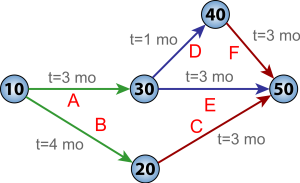History
The history of CPM can be traced back to 5,000 Years ago, the time of ancient civilizations during the making of the Great Pyramid of Giza, the Egypt Capital City. The construction of the Pyramid took 20 years to complete and the workers were organized into four construction teams which were built using over two million blocks of stones.
The modern method of Project Management was introduced in the mid-1900 by American mechanical engineers Frederick Taylor and Henry Gantt. They came up with a graphic method for planning, controlling, and tracking a work schedule which is known as Gantt charts.
The Gantt chart is a type of bar chart where varying lengths of horizontal bars represent each activity’s time span, and the vertical axis lists the separate activities making up the project. It was used in the 1931 Hoover Dam construction project. Gantt charts are still in use today because they are easy to understand.
The critical path method was developed in the late 1950s by Morgan R. Walker of DuPont and James E. Kelley Jr. of Remington Rand.
In 1958, the US Navy along with Lockheed Missile Systems, an aerospace company, and Booz Allen & Hamilton, a consultancy firm devised another technique called Program Evaluation Review Technique (PERT). Like CPM, PERT was also designed to deal with the interrelationship between different activities in a project.
Effective construction project scheduling is essential for ensuring timely delivery and resource management throughout the project’s lifecycle.
CPM in Project Management
The critical path method is one of the frequently used techniques in Project Scheduling and Planning. A project typically has many tasks which involve many people to keep working together till project completion. It is far too easy for certain activities to fall behind and get lost in the sea of endless jobs.
These forgotten tasks and errors in planning can severely affect the timescale of the whole project. A late project will cost money and lead to unhappy customers and bosses. The importance of the Critical path method and scheduling in project management is to help managers figure out two things. How long it will take to complete the project and what are the critical tasks that must be completed before starting other dependent tasks?
Today, the critical path method is used to identify the most important tasks and ensure your project doesn’t fall behind schedule. This also provides a higher level of insight into your project’s timeline and a correlation between tasks, giving you more understanding about which task duration you can modify, and which must stay the same.
What is the Critical Path Method?
The Critical Path Method is a “scheduling technique used to plan, control, and identify the longest stretch of dependent activities and measure the time required to complete them from start to finish”.
Types of Network Diagram in CPM:
There are two common forms Arrow Diagramming Method (ADM) and Precedence Diagramming Method (PDM).
The Arrow Diagramming Method is a technique used to schedule project activity plans as shown below.

Arrow Diagramming Methods
Precedence Diagramming Method is used to construct a project schedule network diagram that uses boxes, referred to as nodes, to represent activities and connects them with arrows that show the dependencies as below.
 To get free Primavera P6 consultation and learn about Primavera P6 scheduling courses offered by Leopard Project Controls, please visit here.
To get free Primavera P6 consultation and learn about Primavera P6 scheduling courses offered by Leopard Project Controls, please visit here.





